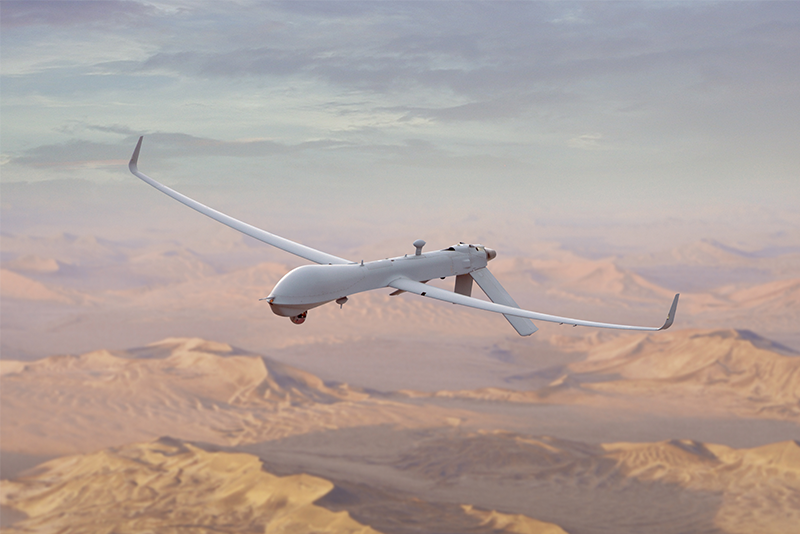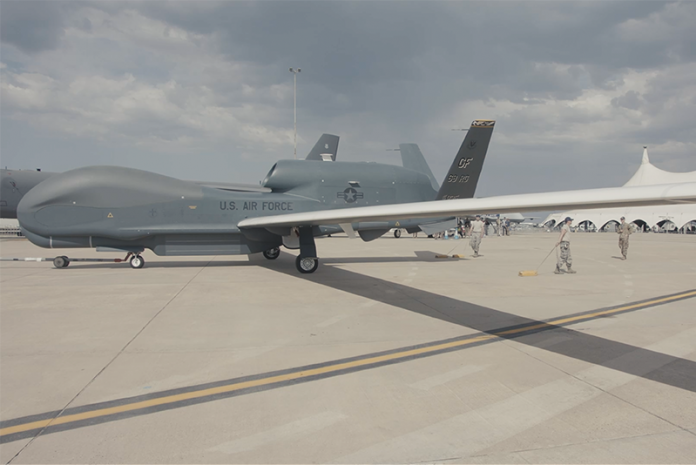Andrew Drwiega – Unmanned aerial systems are increasingly capable of maritime as well as overland ISR, but whatever the mission first rate simulation training will yield the best operational results.
How did the Chinese government manage to conduct such a rapid island building campaign in the South China Sea before it became too late to stop. Going against international laws and ignoring the claims of other nations to the same real estate, the Chinese government rapidly developed port facilities, runways and defence capability. These bases significantly bolstered China’s ability to enforce its ‘nine-dash line’ territorial claim which encompasses most of the South China Sea. Was this a failure of diplomacy – or the lack of an adequate means to conduct meaningful intelligence, surveillance and reconnaissance gathering?
The initial ‘land reclamation programme’ carried out by the Chinese in the Spratly Islands took place between 2013 and 2016. Some of the reefs had been little more than barren rocks were built up into man-made islands. The runways at 2,700-3,300 feet could handle military jets.
In the Pacific, long range and endurance counts. Australia’s acquisition of seven Northrop Grumman MQ-4C Tritons is giving the Royal Australian Air Force (RAAF) a high altitude, long range maritime patrol capability. Ranging out for up to 24 hours at a time at a ceiling well over 50,000 feet (15,000m), its 360 degree field of regard (FOR) sensors can cover over 2,000 nautical miles of surrounding ocean. This is achieved through its multifunction active sensor active electronically steered array (MFAS EASA) radar, electro-optical / infrared (EO/IR) sensor, automatic identification system (AIS) receiver and other electronic support measures (ESM).
Other regional customers for Northrop Grumman’s Global Hawk include Japan, which is acquiring three RQ-4 Block 30i (international) variants which will all be delivered by 2022. The Republic of Korea Air Force (ROKAF) will take delivery of the first two of its four Block 30i UAS in the first half of 2019, following delays in delivery over cyber security concerns by the United States.
Guarding Seas and Skies
With an increased focus by Asian countries on the need to conduct long-range, high endurance maritime patrolling, General Atomics (GA-ASI) considers the right time to promote the maritime version of its Medium Altitude Long Endurance (MALE) MQ-9B SkyGuardian.
A spectacular demonstration of its long ranging capability was witnessed on 11 July, 2018 when an MQ-9B transited across the Atlantic Ocean in a single flight to land at the Royal Air Force’s (RAF) air base at Fairford in Gloucestershire, UK. The UAS had departed from GA-ASI’s Flight Test and Training Centre in Grand Forks, North Dakota, USA. The RAF is the launch customer for the MQ-9B Protector, replacing the MQ-9A Predator, with the first delivery aircraft expected in the early 2020s.
“The new aircraft will offer greater range and endurance, and will be certified to fly in UK airspace,” said Group Captain Lyndon Jones, programme director for the RAF’s Air Intelligence, Surveillance, Target Acquisition, Reconnaissance programmes. He added that ‘detect and avoid’ was a critical system for flying in civilian airspace. The Reaper previously only few in military airspace and during operational deployments.
According to Steven Hendon, GA-ASI’s spokesperson, “MQ-9B is a ground-up redesign of earlier variants. This was done in order to earn certification to fly in non-segregated airspace.” He added, “GA-ASI expects MQ-9B to achieve certification in the early 2020s, when the aircraft initially will meet NATO STANAG-4671 airworthiness standards, and subsequently will meet commercial airworthiness certification standards in cooperation with the .S Federal Aviation Administration (FAA).
Hendon went on to explain that the aircraft’s Detect and Avoid (DAA) system comprises a radar, Traffic Collision Avoidance System [TCAS], Automatic Dependent Surveillance-Broadcast [ADS-B], which, when combined, can alert and provide manoeuvring guidance to the pilot in the Ground Control Station (GCS).
In terms of new features, the wings of the MQ-9B have been extended by four metres (to 24m) giving increased fuel capacity and greater overall lift. This has allowed the addition of two extra hard points for a total of nine, giving a maximum external payload of 4,750 pounds (2,155 kilograms). With the additional fuel the range is now 6,000 nautical miles (nm) with an endurance of 40 hours.
The MQ-9B operates Beyond Line of Sight (BLOS) ranges at altitudes over 40,000 feet (12,192m). its sensor systems include EO/IR Full Motion Video (FMV), Synthetic Aperture Radar (SAR) imagery, and Ground Moving Target Indicator (GMTI) data. Hendon adds: “The platform can also be equipped with a multi-mode maritime search radar, an Inverse Synthetic Aperture Radar (ISAR) capability, and an Automatic Identification System (AIS) detection capability that provides a true Maritime Wide Area Search (MWAS) and allows for the identification and interdiction of maritime targets.”
In addition to the UK and the United States, countries such as Italy and France have GA-ASI MQ-9A systems in their inventory, and the United Arab Emirates operates the Predator RPA. Spain and the Netherlands have MQ-9 systems on order. Discussions are ongoing with several other countries.

GA-ASI is developing an Anti-Submarine Warfare (ASW) capability for the MQ-9B. In 2017, the company conducted a demonstrated of remote detection and tracking of submerged contacts using an MQ-9A. Hendon confirmed that the RPA “used sonobuoys to gather acoustic data and track underwater targets. The data was transmitted to the MQ-9A, processed onboard, and then relayed to the aircraft’s GCS.” hendon added that the company is working on ways for the SeaGuardian’s deliver sonobuoys and “transmit the acoustic data via BLOS SATCOM.” This would provide direct support to manned maritime patrol aircraft.
Getting Simulation Training Right
Operate a UAS such as the MQ-9 demands high skill levels and concentration from its operators. The Armed Forces of the United Arab Emirates (UAE) have come a long way in a short time. Their participation in Saudi Arabia’s coalition operations against Houthi opponents in the Yemeni Civil War that has been raging since 2015 has provided them with a steep learning curve, not least in the necessity to collate intelligence, surveillance and reconnaissance sources together to provide a real-time picture of the military situation, which is always difficult to achieve in an asymmetric war such as that in Yemen.
For a relative newcomer to wide area persistent surveillance, the UAE has committed to an unspecified number of MALE GA-ASI XP/RQ-1E Predator systems with deliveries occurring to the end of 2017. Although believed to be unarmed, the UAE Air Force (UAEAF) set out to ensure that its pilots and sensor operators were proficient and that a flow of qualified personnel was ensured.
To that end, in 2017, CAE announced that it had been awarded a $42 million (C$56 million) contract by the General Headquarters (GHQ) of the UAE to deliver a training package for remotely piloted aircraft (PRA) for the UAEAF and Air Defence.
UAEAF crewmen had been training in the United States at AI-GSA’s Castle Dome training site located at the US Army’s Yuma Proving Grounds in Arizona, which is where CAE’s initial training team also learned how to operate the RQ-1E. However, the logical next-step was to bring that training inside the UAE to the UAEAF’s own RQ-1E operating base.
Initially agreeing a five year contract, CAE’s task was to provide all aspects of RPA training from academic instruction, through to flight simulator training and ultimately live flight training. This was to be delivered by Abu Dhabi based CAE Maritime Middle East.
At the UAE’s biennial defence show, IDEX, staged in Abu Dhabi (17-21 February), CAE confirmed that the simulator was in operation with the UAEAF and that two student groups at the Khalifa Bin Zayed Air College had already undertaken the new RPA Pilot Fundamentals training course with a third group already engaged.
“Remotely piloted aircraft have been proven as an indispensable asset in modern combat operations, and like all platforms they require skilled and proficient aircrews who are prepared for a range of missions,” said Ian Bell, CAE’s vice president and general manager, Middle East/Asia-Pacific.
A CAE spokesman stated that it has already delivered “desktop trainers used in the classroom for basic training, and a generic UAS mission trainer used for familiarisation and procedural training.” The next stage, a high-fidelity RQ-1E type-specific mission trainer is currently in development at CAE.
The UASAF has largely based the timeline of its RQ-1E training programme around the US Air Force programme. This means that it takes up to five months to train a basic aircrew member from start to initial mission combat readiness for a Predator-type MALE UAS such as the Predator.
Additional qualifications such as Launch and Recovery, or instructor upgrade may take another two to three months top of the initial mission training period. A CAE spokesperson said that “training is divided roughly equally between academic/simulator training, and live flying training.” However, this is expected to change significantly with the delivery of the high-fidelity RQ-1E type-specific mission trainer “because that simulator will enable more of the training tasks to be accomplished in synthetic training, thus enhancing training delivery and operational readiness.” This will save flying hours across the RQ-1E fleet which instead can be allocated for actual missions. It will also allow a greater range of mission scenarios to be created and flown, perhaps simulating operational deployments beyond the ‘home base’ requirements of the Gulf region.
The UAEAF is already feeding back its own lessons learned through operational experiences into the training programme to modify CAE’s original courseware for their own specific operational needs.
The UAEAF’s RQ-1E specific Predator Mission Trainer is being developed using the foundation of the Italian Air Force programme. CAE developed a Level D simulator – the highest qualification for flight simulators – for the Italian Air Force Predator mission simulator, although the UAEAF’s RQ-1E is a substantially different system to the Italian MQ-9A/B. The ground control systems (GCS) used to control both Predator types are different: ”RQ-1E uses the upgraded Block 30 GCS so the simulator we are developing reflects that while the Italian Air Force has a Block 15 GCS,” stated a CAE spokesman.

The mission trainer will use CAE’s Medallion-6000 image generator with Common Database (CDB) architecture, which was recently adopted by the Open Geospatial Consortium (OGC) as an international standard for the creation of synthetic environment databases. According to CAE, “this common software and standardisation, which are also being deployed on naval and helicopter training systems that CAE is currently developing for the UAE, will further enhance networked, interoperable mission training across the UAE Armed Forces.”
Military forces that set in place an ambitious and technologically advanced training programme that will allow them to maximise the benefit of owning ISR capable UAS, whether for border security or wider military missions, will see their investment returned with interest.













